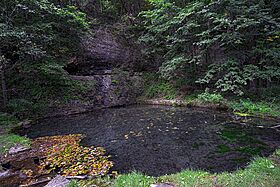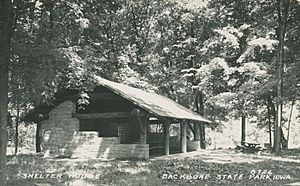Backbone State Park facts for kids
Quick facts for kids Backbone State Park |
|
|---|---|

Richmond Springs
|
|
| Lua error in Module:Location_map at line 420: attempt to index field 'wikibase' (a nil value). | |
| Location | Delaware County, Iowa, United States |
| Nearest city | Dundee, Iowa |
| Area | 2,001 acres (810 ha) |
| Established | 1919 (purchase); 1920 (dedication) |
| Administered by | Iowa Department of Natural Resources |
|
Backbone State Park Historic District
|
|
| Area | 1,415 acres (573 ha) |
| Built | 1933-1942 |
| Architect | John R. Fitzsimmons |
| Architectural style | Rustic |
| MPS | CCC Properties in Iowa State Parks MPS |
| NRHP reference No. | 91001842 |
| Added to NRHP | December 23, 1991 |
Backbone State Park is Iowa's very first state park! It opened way back in 1920. You can find it in Delaware County, about three miles (5 km) south of Strawberry Point. The park gets its name from a cool, narrow, and steep rock ridge. This ridge was carved by a loop of the Maquoketa River and was once called the Devil's Backbone.
A man named E.M. Carr donated the first 1,200 acres (486 ha) for the park. In the 1930s, a group called the Civilian Conservation Corps (CCC) built a small dam. This dam created Backbone Lake. The CCC also built most of the trails and buildings you see in the park today.
Contents
Park History: How it Started
The "Devil's Backbone" area was a favorite spot for scientists. They came to study its very old rock formations. Edward M. Carr bought 1,200 acres (486 ha) in the 1890s. He wanted to protect the Backbone Ridge from being destroyed.
Scientists and members of the Iowa Park and Forestry Association thought it would be a great place for a state park. The State Board of Conservation agreed in 1918. It took about a year to buy the land. On May 28, 1920, Backbone officially became Iowa's first state park.
Building the Park with the CCC
Work on the park really began in 1925. Trees were planted, and plans for roads were made. In the 1920s and 1930s, people had different ideas for the park. Some wanted to keep it completely wild. Others wanted to use it for many activities. The idea of using it for many things won out.
Two groups from the Civilian Conservation Corps (CCC) helped build the park. The CCC was a program during the Great Depression. It gave jobs to young men. From 1933 to 1942, these CCC workers built cabins and recreation areas. They also created picnic spots, hiking trails, and camping areas. They even worked on Richmond Springs at the north end. Backbone became one of Iowa's largest and most developed state parks.
Historic Buildings and Features
Many parts of the park are now considered historic. They were added to the National Register of Historic Places in 1990 and 1991. These areas show off the amazing work done by the CCC.
Some of the historic features include:
- Stone entrances at the north end.
- Stone dams to stop soil erosion.
- An auditorium and stone restrooms.
- Stone steps for trails and stone walls.
- Trout rearing ponds and a fish hatchery garage.
- Stone drinking fountains and a stone pumphouse.
- A stone lodge, now used as a museum.
- A stone barn and four special markers.
One marker remembers the Daughters of the American Revolution. They planted 6,000 trees in the park. Other markers honor people important to the park's creation. These include State Senator Byron W. Newberry, State Treasurer E.H. Hoyt, and landowner E.M. Carr.
Cabins and Lake Area
This area is at the park's southern end, around Backbone Lake. The lake is about 125 acres (51 ha) big. It was created by a dam built by the CCC between 1933 and 1934.
The CCC also built a bathhouse and a boathouse by the lake. These buildings are made of rough limestone. There's also a cool sundial and a stone bench near the bathhouse. Eighteen cabins were built between 1937 and 1941. These are simple, single-story wooden cabins.
Picnic, Hiking, and Camping Areas
This central part of the park has many places for fun. The CCC started building picnic spots in 1933. They also worked on the Backbone Trail. This trail follows the top of Backbone Ridge.
You can find picnic shelters and restrooms here. One picnic shelter also has a concession stand. These buildings are made of limestone and oak wood. Watercrest Springs is a pretty spot with stone walls and a shallow pool. It's a natural spring that was made even nicer by the CCC.
Richmond Springs
Richmond Springs is at the north end of the park. It's a natural spring that the CCC improved between 1934 and 1935. They built a new channel for the water. This helped protect the springs, which were a source of clean drinking water.
Exploring Backbone State Park
The park covers 2,001 acres (810 ha) and is full of trees like oak and maple. The rocks here are very old and special. This area is part of the "Driftless Area." This means it wasn't covered by glaciers during the last Ice Age. You can see ancient dolomite rocks from the Silurian period.
A large rock ridge, like a spine, runs through the park. This is where the park gets its name! The area has active springs, cool caves, and sinkholes. Some cliffs are over 80 feet (24 m) tall. If you want to go climbing or rappelling, you'll need a permit.
Fun Activities for Everyone
Backbone State Park has 21 miles (34 km) of trails. You can hike them all year round. In winter, you can even go cross-country skiing or snowmobiling!
Backbone Lake is great for swimming, boating, and fishing. Backbone Creek is home to rainbow and brown trout. The Iowa Department of Natural Resources keeps the creek stocked with fish. The park also has campsites, cabins, shower buildings, and a playground.
Right next to the park is Backbone State Forest. It has 186 acres (75 ha) of pine trees. Here, you can go horseback riding, hiking, hunting, and cross-country skiing.
Iowa Civilian Conservation Corps Museum
The Iowa Civilian Conservation Corps Museum is a great place to learn. It shows what the Civilian Conservation Corps (CCC) did in Iowa's state parks. Since Backbone State Park had two CCC camps, many of its buildings and trails were built by these workers. The museum opened in 1991.


